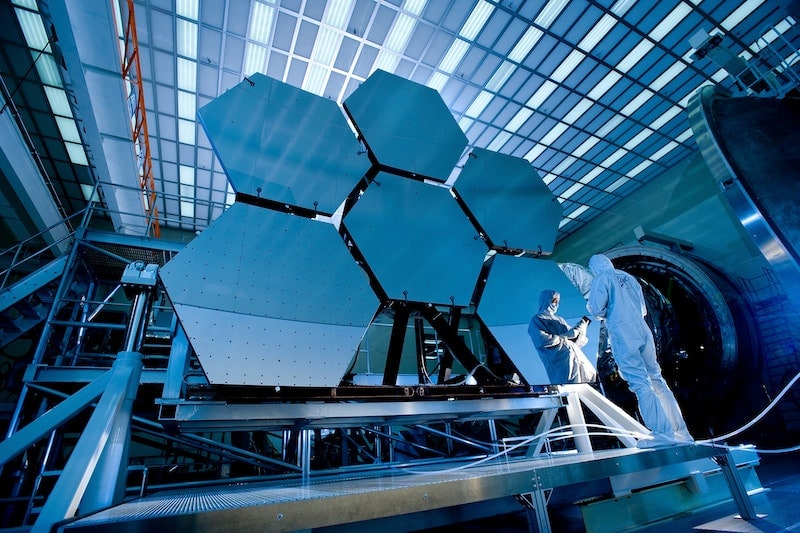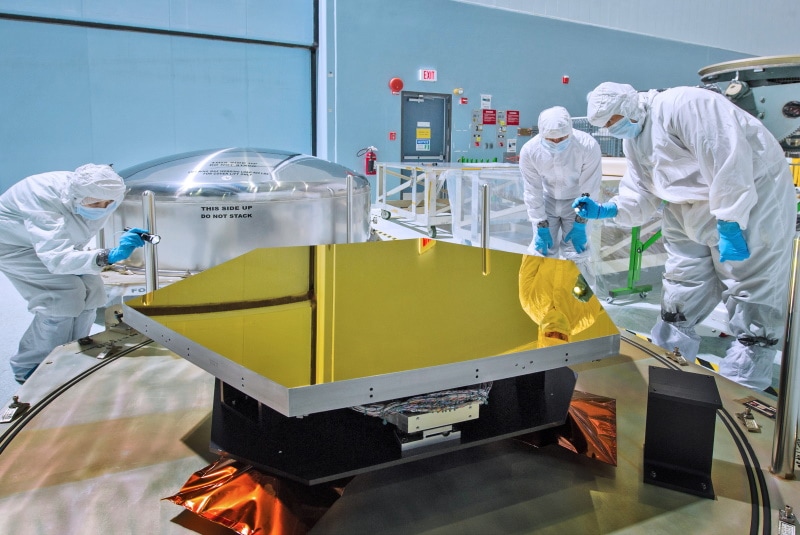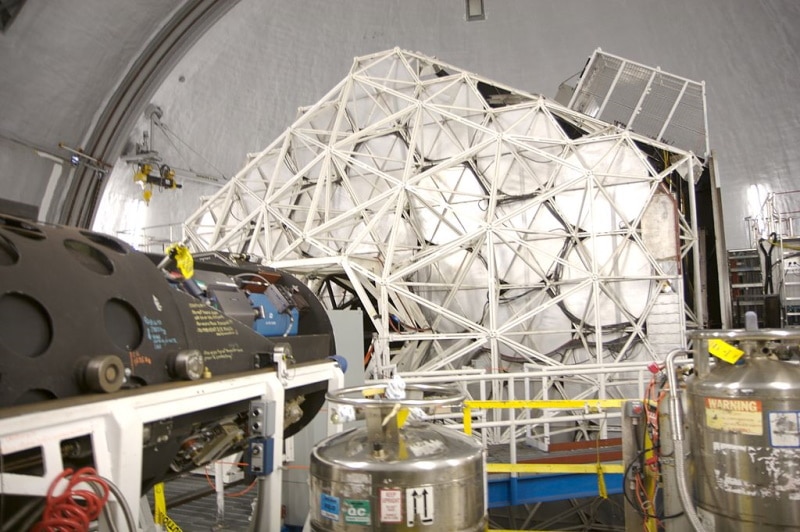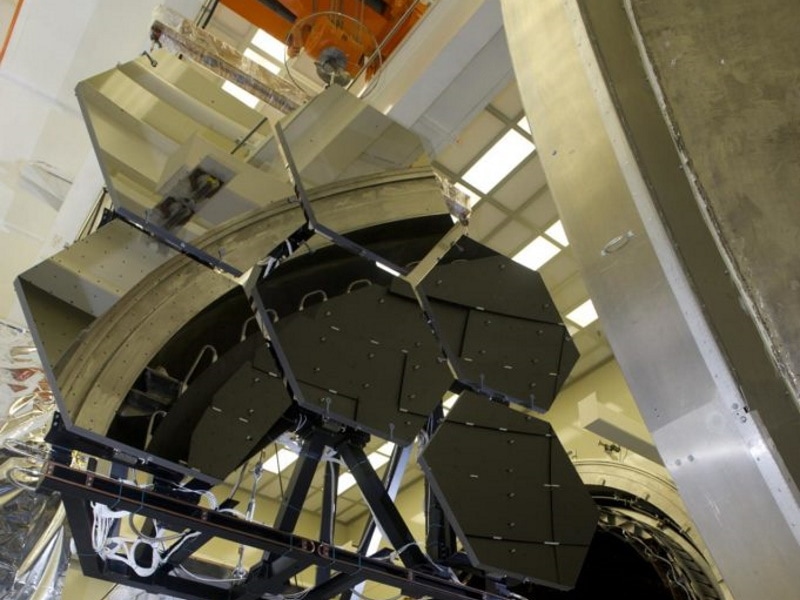What Is a Liquid-Mirror Telescope? The Interesting Answer!
Last Updated on

A liquid-mirror telescope is a reflecting telescope that uses a liquid surface as the primary mirror. The liquid surface can be formed by spinning a small container of mercury, and it can reach huge diameters (up to 10 meters) at a fraction of the cost of conventional telescopes.
Liquid-mirror telescopes are ideal for astronomical observations, including studies of the Sun, planets, stars, and galaxies. Recently, the International Liquid-Mirror Telescope (ILMT) was put at the Devasthal Observatory campus in India.
The telescope will help in many astronomical studies, including sky surveys for transient events such as supernovae and gamma-ray bursts. It is the first-ever telescope in the world commissioned for astronomical purposes. Let’s learn more about liquid-mirror telescopes and how they work.

How Does It Work?
The working mechanism of a liquid-mirror telescope depends on the fact that a rotating liquid can form a paraboloidal shape. When the liquid is spinning, the weight of the fluid creates a pressure gradient from the center of the dish to its edge. The pressure difference causes the liquid to bulge outward at the equator and form a paraboloid shape.
But what’s so special about a paraboloid? A paraboloid is a surface whose cross sections are all parallel to each other. It means that all the light that hits the surface of the liquid will be focused on a single point. That’s the principle of how liquid-mirror telescopes work: the light from a distant object hits the surface of the liquid and is focused on a single point. By placing a detector at that focal point, you can take a clear picture of the object.
A liquid-metal mirror is also less expensive than a solid glass mirror. That’s because the rotating mercury can take the place of the costly glass mold needed to create a paraboloidal shape.
Isaac Newton noticed a phenomenon that we use in building liquid-mirror telescopes today. He saw that a circular paraboloid forms when a liquid rotates. Although he understood the free surface of such a liquid, he did not have the means to stabilize rotation speed. Thus, he could not build a telescope.
Ernesto Capocci later advanced the concept in 1850. However, it still took a few more decades for Henry Skey to build the first liquid-mirror telescope in 1872.
Even today, we are learning more about liquid-mirror telescopes. For instance, researchers are trying to find ways to create a liquid-mirror telescope that can tilt and turn.
What Are the Different Types of Liquid-Mirror Telescopes?

Liquid-mirror telescopes are a relatively recent technological development that offers several advantages over traditional telescopes. There are typically three types of liquid-mirror telescopes.
Conventional Liquid-Mirror Telescopes
These are land-based telescopes. It means they are set up on a mountaintop or in a remote location. The telescope’s primary mirror comprises a liquid, usually mercury.
The liquid is in a bowl-shaped vessel that rotates to direct the light toward the focal point. The liquid is present in a cylindrical container with a Kevlar build. It could also be any other composite material, but Kevlar is the most common option.
Kevlar can withstand the weight of mercury without collapsing. The inner surface of the container has a thin layer of silver coating.
The cylinder spins until reaching a few RPMs (revolutions per minute). Then, gradually, it begins to form a paraboloid. As a result, the liquid-mirror telescope can capture a very clear image. Clarity is one of the main advantages of this type of telescope.
Another advantage is the low cost of construction. In addition, the entire telescope can be assembled using materials that are very easy to find.
Space-Based Liquid-Mirror Telescopes
As evident from the name, these telescopes are in space. Therefore, they are also known as Orbitscopes. The design is very similar to that of the conventional liquid-mirror telescope. The only difference is that the cylindrical container is in a weightless environment. As a result, the liquid inside does not need to be held in place by any external force.
The liquid can be allowed to float freely inside the cylinder. Such a telescope is very stable and can capture clear images.
The main advantage of space-based liquid-mirror telescopes is that they are not affected by the Earth’s atmosphere. As a result, the images captured by these telescopes are much sharper and clearer than those captured by land-based telescopes.
Moon-Based Liquid-Mirror Telescopes
Scientists have also proposed placing a liquid-mirror telescope on the Moon. The advantage of such a telescope would be that it would be permanently dark. It will have a low temperature of fewer than 130 kelvins. Plus, there will be a spinning liquid mirror that will constantly reflect light.
Low temperature helps in forming images of long-wave infrared light. The distant planets in the universe give off this light. Therefore, if we want to study those planets, we need a telescope that can capture this light.
The moon-based liquid-mirror telescope will be very helpful in this regard. However, the main challenge will be to build a telescope that can withstand the harsh conditions on the Moon. It will also be more costly than the other two types of telescopes.

Where Is It Used?

Liquid-mirror telescopes help us observe objects in space that are too far away and too faint to be seen with a regular telescope. They are also used to study the Sun and make precise measurements of star positions. Doing so is essential for understanding the motions of stars and how they change over time.
In astronomy, a liquid-mirror telescope can help astronomers gaze at very distant objects in space, such as galaxies that are billions of light years away. In addition, astronomers can use it to study the structure and evolution of galaxies and search for new ones.
The International Liquid Mirror Telescope (ILMT) is the first liquid-mirror telescope used explicitly for astronomy. With an elevation of 2,450 meters, the telescope is 4 meters in diameter. The primary mirror of the ILMT is made of liquid metal, such as mercury, that is constantly rotating. It gives the telescope a large field of view that allows it to take long-exposure pictures, which is essential for observing faint objects. The ILMT also has a secondary mirror to focus the light.
Advantages of Liquid-Mirror Telescopes
Now that a liquid-mirror telescope has been installed in the Indian Himalayas, there’s a lot of interest in this technology. Here are some of the advantages that make liquid-mirror telescopes so attractive:
Low Cost
Telescopes generally tend to be very costly. That makes sense, considering they need to be very precise instruments. But the liquid-mirror telescope is different.
The highest cost of a liquid-mirror telescope is the mirror itself. But even that’s not as expensive as it would be for a regular telescope. That’s because the liquid mirror can be made from various materials, including mercury.
The low cost allows more people to access this type of telescope. That’s important because it means more people can study the universe.
The cost of the Large Zenith Telescope, a six-meter telescope, is 1/50th of what it would cost the University of British Columbia to make a conventional telescope. That’s almost nothing in the world of astronomy.
Ease of Use
Another advantage of liquid-mirror telescopes is that they’re much easier to use than regular telescopes. That’s because there are no moving parts. All you need to do is point the telescope in the right direction and let it do its job.
Ideal for Cosmological Principle
The cosmological principle is the idea that the universe is uniform on a large scale. That means that what you see in one direction should be the same as what you see in another.
The principle states that the universe is homogeneous and isotropic. Simply put, it means that the universe looks the same from every point of view.
Liquid-mirror telescopes are perfect for this type of research because they can take large and profound images. That’s important because it allows astronomers to study the universe on a large scale.
Disadvantages of Liquid-Mirror Telescopes
Although there are many advantages to liquid-mirror telescopes, there are also some disadvantages. Here are the most notable ones.
It Cannot be Tilted
The most significant disadvantage of liquid-mirror telescopes is that they cannot be tilted. That means they can only take pictures of the sky directly overhead.
You can only point the telescope looking straight up. There is research underway to manufacture a titling liquid-mirror telescope. But at the moment, it’s not possible to track an object with a liquid-mirror telescope. That’s because the telescope would lose focus if it were tilted. As a result, the object would also move out of the field of view.
Toxicity of Mercury
Mercury is the most common material used to make liquid-mirror telescopes. But it’s also a very toxic substance. It’s so toxic that even a tiny amount can cause health problems. That’s why it’s essential to be very careful when handling mercury.
British Columbia University has housed the human operators and the Large Zenith Telescope in different rooms. These rooms are ventilated to avoid any contact with mercury vapor.
An alternative to mercury is gallium. It can also be used to make liquid-mirror telescopes. But it’s pretty expensive and would raise the cost of the telescope.
Canadian researchers have proposed using silver nanoparticles, iron, and ethylene glycol suspension to create a liquid-mirror telescope. But this mixture is still being tested and is not yet ready for use. When ready, it can be instrumental in liquid-mirror astronomy. For one, it has lower toxicity than mercury. Plus, it is also cheaper. Researchers can also deform it easily with magnetic field strength variations.
Frequently Asked Questions (FAQs)

What Are Liquid-Mirror Telescopes Made Of?
A typical liquid-mirror telescope is made of a large, shallow dish filled with mercury. The surface of the mercury is kept very smooth by constantly rotating the dish. As a result, the mercury forms a paraboloidal shape, which is ideal for reflecting light.
Is Liquid Mercury Reflective?
Yes, mercury is an excellent reflector of light. It is so good at reflecting light that it is used in many types of mirrors, including those found in telescopes.
What Is the Resolution of a Liquid-Mirror Telescope?
The size of the mercury droplets limits the resolution of a liquid-mirror telescope. The larger the droplets, the worse the resolution.

Summing Up
Summing it up, liquid-mirror telescopes are ideal for astronomy. They contain mercury, which is a liquid metal. They rotate the mercury to create a parabolic surface, which is a perfect mirror. Liquid-mirror telescopes are very cheap to build and can be used in any weather conditions.
With a lower cost of building and operating, along with the elimination of moving parts, liquid-mirror telescopes will significantly impact the field of astronomy. Of course, many challenges still need to be overcome, but with continued research and development, liquid-mirror telescopes will become a staple in astronomical research.
Featured Image Credit: Pixabay, Pexels
About the Author Jeff Weishaupt
Jeff is a tech professional by day, writer, and amateur photographer by night. He's had the privilege of leading software teams for startups to the Fortune 100 over the past two decades. He currently works in the data privacy space. Jeff's amateur photography interests started in 2008 when he got his first DSLR camera, the Canon Rebel. Since then, he's taken tens of thousands of photos. His favorite handheld camera these days is his Google Pixel 6 XL. He loves taking photos of nature and his kids. In 2016, he bought his first drone, the Mavic Pro. Taking photos from the air is an amazing perspective, and he loves to take his drone while traveling.
Related Articles:
What Is the Best Binocular Magnification for Hunting? Optical Features Explained
How to Clean a Refractor Telescope: Step-by-Step Guide
How to Clean a Telescope Eyepiece: Step-by-Step Guide
How to Clean a Rifle Scope: 8 Expert Tips
Monocular vs Telescope: Differences Explained (With Pictures)
What Is a Monocular Used For? 8 Common Functions
How to Clean a Telescope Mirror: 8 Expert Tips
Brightfield vs Phase Contrast Microscopy: The Differences Explained
